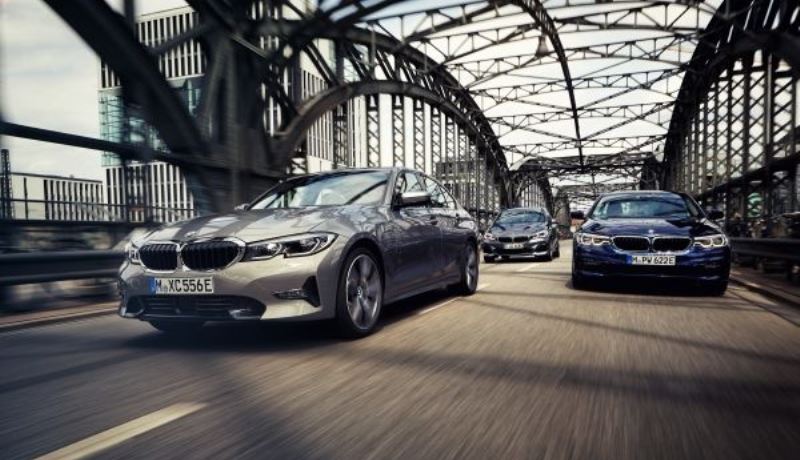
Munich. A combination of peerless dynamics and exemplary efficiency defines the character of the new BMW 3 Series Sedan. And now the addition to the range of drive solutions of a plug-in hybrid system brings an extra, particularly future-focused angle to the new sports sedan’s core attributes. The latest generation of BMW eDrive technology teams up with a four-cylinder petrol engine to significantly enhance the sporting prowess of the new BMW 330e Sedan (whose worldwide market launch is now underway) and deliver an even richer electric driving experience. Making its debut appearance in a BMW, the standard-fitted XtraBoost raises the system output of the plug-in hybrid to a maximum 215 kW/292 hp. The lightning-fast responses of the drive system headline the new BMW 330e Sedan’s driving characteristics. Added to which, its electric range is over 50 per cent greater than that of its predecessor; 66 kilometres (41 miles)* is possible with zero local emissions. Fuel consumption and emissions are down by more than 15 per cent on the levels of the predecessor model – to 1.9 – 1.6 litres per 100 kilometres (148.7 – 176.6 mpg imp)* and 43 – 37 grams of per kilometre*.
In the new BMW 330e Sedan, the intelligently controlled interplay of electric motor and combustion engine reaches a whole new level. The electrification of the powertrain contributes more than ever not only to increasing efficiency but also to a distinctive form of driving pleasure. The plug-in hybrid system pools the abilities of a 2.0-litre four-cylinder petrol engine with BMW TwinPower Turbo technology and output of 135 kW/184 hp with the talents of an electric motor, which generates peak output of 83 kW/113 hp. Together, the two drive sources produce maximum system torque of 420 Nm (310 lb-ft).
Premiere in the new BMW 330e Sedan: XtraBoost for maximum dynamic performance.
A brand-new feature – and included as standard in the new BMW 330e Sedan – is XtraBoost, which reveals the car at its most dynamic. The driver can quickly bring XtraBoost into play by activating SPORT mode with the Driving Experience Control switch. A vigorous stamp on the accelerator uncorks an additional 30 kW/40 hp on top of the combined 185 kW/252 hp already generated by the combination of electric motor and combustion engine – and XtraBoost keeps it on tap for up to 10 seconds. The result is the signature powertrain character of the BMW 3 Series Sedan, comprising (for the first time in a hybrid model from BMW) incredibly sporty yet also precise accelerator response, and a specific shift program for the eight-speed Steptronic transmission including engine-braking downshifts.
The instant-impact XtraBoost delivers a significantly more intense experience of acceleration than a conventionally powered vehicle with comparable output could offer. For example, if the driver suddenly puts their foot down hard from 20 km/h (12 mph), in as little as a second the new BMW 330e Sedan accelerates with around twice the vigour of a car powered solely by a combustion engine. Within three seconds, it opens up a car’s-length gap. XtraBoost can still be accessed with the high-voltage battery at minimum charge, as well as in kickdown and with the transmission selector lever in the M or S position.
The new BMW 330e Sedan sprints from 0 to 100 km/h (62 mph) in 5.9 seconds en route to a top speed of 230 km/h (143 mph). The driving experience is accompanied by a model-specific and emotionally engaging drive system note, which also finds its way into the interior. And so the new BMW 330e Sedan vividly showcases its sporty and dynamic side, blended with the proven qualities of a plug-in hybrid car.
Pure-electric driving at up to 140 km/h (87 mph).
In the HYBRID driving mode, the new BMW 330e Sedan can hit speeds of up to 110 km/h (68 mph) on electric power alone – an increase of 30 km/h (19 mph) over its predecessor. And ELECTRIC mode opens the door to locally emission-free driving at 140 km/h (87 mph), up from 120 km/h (75 mph). Hybrid-specific standard features of the new BMW 330e Sedan include acoustic pedestrian protection. When driving on electric power, an exterior speaker system generates an unmistakable sound created specifically for electrified BMWs. At low speeds, the drive system’s bespoke note exudes aural presence, without impinging on the acoustic comfort of those on board.
The new BMW 330e Sedan’s electric motor is integrated into the eight-speed Steptronic transmission, saving space. Intelligent design allows the hybrid-specific version of the transmission to be no more than 15 millimetres longer than corresponding variants for conventionally powered variants of the new BMW 3 Series Sedan. Power generation by means of braking energy recuperation, where the electric motor plays the role of a generator, works particularly effectively. The electric energy channelled into the high-voltage battery either in this way or when plugged into the power grid also feeds the 12-volt on-board power supply. All of which renders a combustion engine-driven generator surplus to requirements and further enhances overall system efficiency.
High range and efficiency bring tax benefits.
With a gross energy content of 12.0 kWh, the lithium-ion high-voltage battery in the new BMW 330e Sedan enables an increase in electric range of more than 50 per cent over its predecessor – to 59 – 66 kilometres (37 – 41 miles)*. Meanwhile, the second generation of the plug-in hybrid sports sedan cuts fuel consumption and emissions by over 15 per cent to 1.9 – 1.6 litres per 100 kilometres (148.7 – 176.6 mpg imp)* and 43 – 37 grams of CO2 per kilometre*. The combined-cycle electric power consumption of the new BMW 330e Sedan is 15.4 – 14.8 kWh per 100 kilometres*. With its low CO2 emissions and long electric range, the new BMW 330e Sedan fulfils all the requirements for reduced company car tax in Germany, where only half the gross list price is taken as a basis in determining the benefit of kind for private use.
The high-voltage battery in the new BMW 330e Sedan is mounted under the rear seats, while the petrol tank sits over the rear axle. This means the plug-in hybrid’s cargo-carrying ability is only slightly reduced, and load capacity of 375 litres can be expanded as required thanks to the 40 : 20 : 40 split/folding rear-seat backrests.
Customers opting for the plug-in hybrid model can choose from virtually the full list of options otherwise available for the new BMW 3 Series Sedan. The new BMW 330e Sedan is also offered in Advantage, Sport Line, Luxury Line or M Sport form as an alternative to basic specification. And it can be ordered with features including Adaptive M suspension with variable sport steering and M Sport brakes. From November 2019, the new BMW 330e Sedan will also be available with a trailer coupling with electrically pivoting hitch ball. The maximum trailer load for the plug-in hybrid model is 750 kilograms.
Auxiliary heating and air conditioning as standard.
The full selection of innovative comfort- and safety-optimising driver assistance systems – from the Driving Assistant Professional with steering and lane control assistant to the Parking Assistant including reversing assistant – is also available. Standard specification for the new BMW 330e Sedan includes preconditioning of the interior with the heating or air conditioning. Energy stored in the high-voltage battery is used to power the auxiliary heating. In low outside temperatures, this means the interior can be warmed up with user-friendly ease before getting into the car, even when the battery charge is low. This interior preconditioning function also allows the interior to be cooled in higher ambient temperature.
With the launch of the new BMW 330e Sedan, new digital services will be presented which make charging the high-voltage battery during a journey even easier and more attractive. Selecting a public charging station prompts the navigation system to come up with recommendations on nearby hotels, restaurants, cafés and sights or cultural centres. And it is also possible to check the whereabouts of charging stations via the display and control system. The driver can likewise check the predicted availability of public charging points at the time of arrival. Added to which, it will be possible to reserve charging points for a limited time, should this facility be offered by the charging infrastructure operator in question.
The drive technology presented in the plug-in hybrid model variant of the new sports sedan will also be available in the new BMW 330e Touring from summer 2020. This will be the first time customers ordering a Touring model from BMW can choose a plug-in hybrid drive system. The new offering sees BMW forging ahead with its model offensive for vehicles with electrified drive systems.
BMW plug-in hybrid models offer an array of benefits in everyday use.
BMW’s plug-in hybrid drive systems already offer users a host of additional benefits over traditional solutions:
- Money-saving: Electric driving in urban areas is cheaper than using petrol or diesel if the plug-in hybrid vehicle is charged at home or at the workplace at low cost.
- Interior always at the right temperature, even before you get in: auxiliary heating and auxiliary air conditioning are fitted as standard.
- Braking is winning: The battery is charged under braking. In conventional vehicles, braking generates only heat and brake dust.
- The best of both worlds: Plug-in hybrids provide electric driving pleasure in urban areas and classical BMW driving pleasure over longer distances.
- Smoothing the way into the future: Because a plug-in hybrid can run emission-free, it is eligible to enter many low-emission zones, enjoys extra parking privileges and saves on toll charges.
- Better quality of life in cities: By driving on electric power, users can actively contribute to reducing emissions and traffic noise in cities.
Future-proof: BMW eDrive Zones ensure emission-free driving in low-emission zones.
The new BMW 330e Sedan is ready to take advantage of low-emission zones designated by cities exclusively for zero-emission driving. With the new BMW eDrive Zones function (which will be part of standard equipment for BMW plug-in hybrid models from 2020 and can be retrofitted), geofencing technology will make it possible to detect low-emission zones automatically. When entering these zones, the vehicle switches into pure-electric driving mode automatically, from which point it behaves like a fully-electric vehicle and can therefore enjoy equal access rights (subject to local regulations). The new function ensures the potential of plug-in hybrid vehicles is utilised to even greater effect. The increase in the proportion of journeys driven on electric power not only plays a role in optimising efficiency, it also helps to reduce operating costs for customers. This applies to driving in urban areas, in particular, where an electric drive system delivers a higher level of efficiency across the board than a petrol or diesel engine.
New BMW 330e Sedan has a smaller overall CO2 footprint.
The “real” environmental impact of plug-in hybrid vehicles has been questioned on occasion, especially in markets where the proportion of green energy used by the public energy grid remains small. The BMW Group conducted a full-cycle CO2 certification for the new BMW 330e Sedan – from raw material procurement, the supply chain, production and the use phase, all the way to recycling.
This revealed the CO2 footprint of the new BMW 330e Sedan to be 20 per cent smaller than that of the new BMW 330i Sedan when running on average European power in the use phase. When charging the car with green energy, its CO2 footprint is reduced by as much as 60 per cent.




































